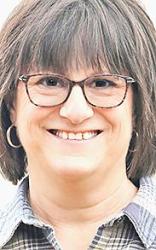Starry, starry night

M
y older brother became fascinated with astronomy at a young age. One year he got a telescope for Christmas. It may have come from Sears, or another of the mail order giants. We pored over their catalogs before the holidays.
Our farmhouse had three bedrooms and six inhabitants. I slept beside my sister, on the “against the wall” side of the bed, so I wouldn’t fall off. On clear nights, when stargazing was too splendid to keep to himself, my brother would use a yardstick to reach over her and tap me on the shoulder.
“Come outside,” he’d whisper. “I found something good.”
I’d crawl out the foot of the bed and head to the pasture with him. It might be a double star, or the Andromeda galaxy. Maybe the red spot on Jupiter was especially clear that night, or her moons, or the mysterious rings that encircle Saturn.
Whatever it was, I dutifully peered through the lens of the telescope and marveled at the wonder of it all while he explained the earth’s rotation and how to identify the constellations.
Eventually my brother moved up in telescopes, until he had one roughly the size of a hot water heater. (I exaggerate, but only a little.) He gazed at the night sky from a few different hemispheres during his tour in the Navy, and he’s visited observatories and joined astronomy clubs wherever he’s lived since then.
He tried to advise me on how to spot the Southern Cross when I lived in Panama, but I was never sure I found it. Identifying constellations was easier when we were kids and I could follow his hand while he explained the coordinates.
I smiled to myself the day we opened our elementary science books and read about The Human Eye and its two kinds of light-detecting cells—rods and cones. I already knew about them. My brother had taught me not to look straight at the dimmest stars, but to try and see them from the corner of my eye, where my “rods” would detect them. Rods are better in dim light, he said. The cone cells at the center of my vision were better with brighter light, and seeing colors.
May I tell you, basic science is best taught in the middle of the night, preferably in an open pasture with a telescope nearby?
We’re fortunate in rural areas. We don’t have much light pollution. When we step outside at night, it’s truly dark. As a kid, I traipsed out in the dark to feed baby pigs, carrying a bucket full of glass pop bottles my mom had filled with warm milk replacer. I shot baskets by moonlight at the hoop we rigged to a telephone pole. When I got older, I took my sleeping bag and slept outside on our lawn chair. I liked the way the air changed overnight. I liked to hear owls talking and cattle shuffling for position at the tank.
And now and then, there would be one of those perfect nights. Do you know the ones I mean? When the air is fresh, not cold but somehow bracing, and taking a deep breath is like drinking a glass of cool water on a warm summer day? And you feel small compared to the stars and the great air masses towering over you, but somehow significant too, like you’re part of something quiet and important and timeless? Those nights are still my favorites.
Scary movies try to sell nighttime as creepy and menacing. I don’t buy it, and I’m something of an expert. As I get older, I experience more conscious nighttime hours than I have since those days of stargazing with my brother. Seems like waking up at 3 a.m. is a natural part of the aging process.
Maybe I should buy a telescope. Maybe we all should, so we can marvel at one of life’s greatest wonders—a starry night.
